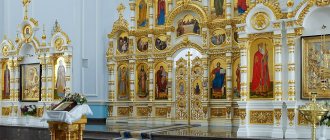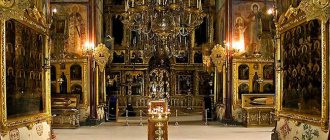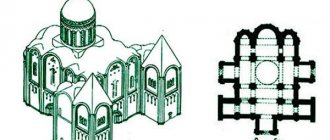The Assumption Cathedral in Yaroslavl is the main temple of the city, as it has the status of the Cathedral of the Russian Orthodox Church. The white-stone religious building with five domes sparkling in the sun, majestically rising above the right bank of the Volga, is rightfully considered one of the symbols of the ancient city, its calling card and a place of pilgrimage for believers.
For centuries, with a break of several decades, the Assumption Cathedral housed the holy relics of the noble Yaroslavl princes Vasily and Constantine, as well as the Yaroslavl Icon of the Mother of God, especially revered by the Christian Church.
Hotels near the Assumption Cathedral in Yaroslavl
Facade of the Assumption Cathedral, © Svetlana Aubekerova
History of the Assumption Cathedral
The Yaroslavl Cathedral is located on the site of a temple that previously existed here, references to which were identified in chronicles of the 13th century as the first stone church of the city. It was built in 1215 by the will of the Prince of Rostov and Vladimir Konstantin Vsevolodovich (1185-1218) on the territory of the fortress that protected the city, located on the spit of the Volga and its right tributary - the Kotorosl River. Consecrated in 1219 on the feast of the Dormition of the Blessed Virgin Mary, it became the main cathedral of Yaroslavl.
During the Time of Troubles in Russia (1598-1613), marked by a state-political crisis, the Russian-Swedish and Russian-Polish wars, Dmitry Pozharsky, who led the campaign of the people's militias, received a blessing in the Assumption Cathedral in Yaroslavl for the liberation of Moscow from the Polish and Lithuanian conquerors.
During its centuries-old history, the city was repeatedly subjected to incinerating fires, as a result of which the temple became so dilapidated that in 1659, by royal decree, it was ordered to dismantle the previous building in order to erect a new cathedral church in its place. Since then, the building, made in the Byzantine style, with five domes and rich interior paintings made in the period 1671-1674, has undergone virtually no significant changes for several centuries. After the diocesan center was transferred from Rostov to Yaroslavl, the Assumption Cathedral in 1788 received the status of a cathedral. In this regard, it was decided to build a new bell tower. It was built according to the design of the architect Melnikov in 1832.
Assumption Cathedral at the beginning of the 20th century, © commons.wikimedia.org
The hard times of the 20th century largely determined the further historical fate of the temple. In 1918, during the White Guard rebellion on July 6, it received significant damage from a direct hit from an artillery shell. Subsequently, the building was repaired and given over to the labor exchange, and from 1930 the cathedral was adapted into a granary. During the next anti-religious campaign carried out by the Bolshevik authorities, on August 26, 1937, the Assumption Cathedral was blown up, and a city park was laid out in its place.
Restoration of the Assumption Cathedral in Yaroslavl
Rethinking the country's past in the late 80s contributed to the revival of the Russian Orthodox Church. It was during this period that old churches began to be revived and new ones were built. The long-standing idea of recreating the historical Assumption Cathedral in Yaroslavl received real confirmation as part of the large-scale celebration of the 1000th anniversary of the Baptism of Rus'. In the competition held, the project of the Moscow architect A. Denisov was approved, who proposed to build a larger structure on the site of the blown up building. The idea of the Yaroslavl restorer V. Safronov, who developed a plan to build an exact copy of the cathedral destroyed in the 30s, was rejected.
During the design work, it was planned to build a 70-meter bell tower, to replace the one demolished in 1922. However, studies of soil conditions at the spout of the Volga and Kotorosl rivers showed that the implementation of the plan in full is impossible due to the weakness of the soil layers. Additional load would lead to subsidence of the massive structure and its further destruction. The soils turned out to be too weak, and laying a deep foundation, replacing the soil or filling the embankment was not justified from either a technical or economic point of view. The huge estimated cost could have caused a long fundraising process and a search for willing investors.
Bird's eye view of the Assumption Cathedral, © Alexander Davidik
The already approved project of the Assumption Cathedral in Yaroslavl was subjected to merciless criticism due to the fact that the exterior of the future structure did not fit into the historical image of the city. The appearance of the temple seemed alien to the Upper Volga folk and cultural traditions. The World Heritage Committee expressed concerns that the newly erected cathedral could change the appearance of Yaroslavl, which is under the auspices of UNESCO.
The Russian entrepreneur Viktor Taryshkin, president of the VIT corporation, engaged in housing construction and restoration of historical buildings, became a patron of the project to revive the Assumption Cathedral.
After archaeological research carried out under the guidance of specialists from the Institute of History of the Russian Academy of Sciences on the eve of the start of construction of the facility, and the transfer of the found artifacts to the fund of the Yaroslavl Museum-Reserve, on October 26, 2005, Metropolitan Kirill installed and consecrated the foundation stone. The construction of the new building of the Assumption Cathedral, which began the following year, continued for four years. The date of its opening and consecration was timed to coincide with the celebration of the millennium since the founding of Yaroslavl - September 12, 2010. On the same day, the holy relics of princes Vasily and Constantine, as well as the Yaroslavl icon of the Mother of God, were returned here.
Iconostasis, © Maxim Massalitin
The Assumption Cathedral in Yaroslavl is the oldest stone building in the city. The Church of the Assumption of the Blessed Virgin Mary was founded back in 1215. Consecrated in 1219, it became the main decoration of the city. Twice, on the site of a dilapidated and fire-damaged church building, a new Church of the Assumption of the Blessed Virgin Mary was erected. In 1937, the cathedral was blown up. For a long time, only trees grew in this place. In the 21st century, for the 1000th anniversary of the city, the Assumption Cathedral in Yaroslavl was rebuilt again. The majestic and beautiful temple made the panorama of Yaroslavl more picturesque.
The first stone temple of Yaroslavl began to be built in 1215 by the will of the Rostov prince Konstantin, the eldest son of Vsevolod the Big Nest. It was dedicated to the Dormition of the Blessed Virgin Mary.
In many Russian cities, the main cathedral was dedicated specifically to the Assumption. This was the case in Yaroslavl. This is the first stone building of the city. She stood in the center of a wooden fortress on Strelka. The Church of the Assumption of the Blessed Virgin Mary was solemnly consecrated in 1219 by Rostov Bishop Kirill.
Of course, the church has not survived to this day in its original appearance. What was the Assumption Cathedral like in the 13th century? This can be judged from individual archaeological finds. The cathedral was built of thin bricks (plinf). White stone reliefs with ornaments and masks are inserted into the walls. Inside, the temple was decorated with an elegant floor made of glazed ceramic tiles. The doors were decorated with gilded copper. Prince Constantine, by whose will the cathedral was built, was buried in this temple.
In its original form, the Church of the Assumption of the Blessed Virgin Mary existed until the beginning of the 16th century. In 1501 there was a fire and the vaults of the church collapsed. The temple was rebuilt around 1516. It was a small church on a basement. In the western part there was a chapel “on the floors” in much the same way as in the Annunciation Cathedral of the Moscow Kremlin. When clearing the rubble after the fire, the relics of the Yaroslavl princes of the 13th century - Vasily and Konstantin Vsevolodovich - were discovered. The relics of the Yaroslavl princes became the main cathedral relic.
After 1605, an illustrated synodik began to be compiled in the Church of the Assumption of the Blessed Virgin Mary. In 1612, during the Time of Troubles, Metropolitan Kirill blessed Dmitry Pozharsky here for the campaign to liberate Moscow.
In the 17th century, the Assumption Cathedral in Yaroslavl was already dilapidated. The temple was damaged during a fire in 1658. And the cathedral was too small for the grown city. Therefore, by decree of the king, a new Church of the Assumption of the Blessed Virgin Mary was built. It was a six-pillar, five-domed building, without a basement; at the northern, western and southern entrances there were stone porches, characteristic of many Yaroslavl churches of the 17th century. An octagonal tented bell tower was erected next to the cathedral.
In 1788 the city became the center of the diocese. Now the Assumption Cathedral in Yaroslavl has become a cathedral. New reconstructions of the temple began. A warm church with a throne in the name of the holy princes Vasily and Constantine was added to the southern wall, and other reconstructions were made. In 1836, a new bell tower was built according to the design of architect A.I. Melnikov. Its height was about 55 meters. The architecture of the bell tower combines features of different styles. The quadrangle of the first tier, then the octagon of the second and then again the quadrangle of the third tier. This is a rather unusual technique; moreover, in the 19th century, octagons were almost never used in architecture. Initially, a passage arch was built at the bottom of the bell tower. The bell tower was built in the traditional romantic eclectic style of that era.
In 1844, the cathedral's domes were the first in the city to be covered with gold. The cathedral had a magnificent five-tiered iconostasis with valuable icons.
Contemporaries of the Assumption Cathedral in Yaroslavl in the 19th century did not write very enthusiastically about it.
This is how full member of the Yaroslavl Scientific Archival Commission I. Barshchevsky describes it in the “Historical Sketch of the City of Yaroslavl” in 1900:
“Belonging to the type of cubic churches borrowed by the Russians from Byzantium, the cathedral is not a beautiful building, moreover, it is also distorted by the spread of windows and extensions. The facades of its walls from the south and north are divided into four by blades, from the west into three parts, and from the east - four altar apses. These shoulder blades are connected at the top by semicircles. Between the blades around the cathedral there are two belts of semi-columns, between which there are windows; the windows of the lower row are chipped.
The cathedral has a hipped roof and five large drums with gilded onion domes; the frieze of the cathedral is painted with scenes from the Holy Scriptures and figures of saints. Extensions were made to its entrance doors on the northern and western sides, which do not correspond in shape to the temple itself; a warm cathedral was built on the southern side...
The large four-tier bell tower of the cathedral was built in 1836 on the site of an ancient tent tower, its height is 26 fathoms, the largest bell weighs 700 pounds. It was cast in Moscow at the Slizov factory in 1754 and donated to the cathedral by manufacturers D. and I. Zatrapeznov.”
And here is a description of the Assumption Cathedral in the book “Yaroslavl in its past and present. Historical essay-guide”, published by the Yaroslavl Excursion Commission in 1913:
“Let's start with the cathedral, which, however, is artistically inferior to many Yaroslavl churches, but is too connected with the history of the city for an inquisitive tourist to pass by it completely indifferently.
Consecrated under the Grand Duke Constantine the Wise in 1215, it is, by the time of its foundation, one of the oldest in Yaroslavl. But rebuilt twice, the last time under Tsar Alexei Mikhailovich in 1646, burned several times and, finally, distorted by the addition of a warm aisle and entrances, the cathedral is a rather tasteless mixture of dissimilar styles.
Still, it is not devoid of solemn grandeur, which is so typical of the Yaroslavl style, “cathedral” par excellence, as the historian of Russian art Igor Grabar defines it.”
The Assumption Cathedral in Yaroslavl was badly damaged during the anti-Bolshevik uprising in 1918, but was then restored. In 1922, the temple was closed for worship, the bell tower was dismantled, after the bells were thrown off it.
The church was given over to the Labor Exchange; from 1930 to 1937 it housed a grain warehouse. In 1937, city authorities decided to demolish the temple itself, and on August 26, 1937, the cathedral was blown up. In the place where the Assumption Cathedral stood, a city park of culture and recreation was laid out.
For the 1000th anniversary of Yaroslavl, it was decided to recreate the Assumption Cathedral in the city. The competition commission chose the project of the Moscow architect Alexei Denisov as the basis for the revival of the temple. The new cathedral was founded on October 26, 2004 on the site of one that was blown up in 1937. The main patron of the project is Moscow businessman Viktor Tyryshkin.
The new Assumption Cathedral in Yaroslavl will not look like the one that was blown up. The area of the temple is about 2000 square meters. meters. More than 4 thousand believers will be able to stay in it at the same time. The height of the cathedral to the base of the cross will be 50 meters, the height of the free-standing bell tower will be 70 meters. In the ground floor of the new church there will be a hall of church councils, a museum, a refectory chamber and the chambers of the ruling archbishop.
Stages of construction of the Assumption Cathedral
The previous building of the cathedral was erected in the 17th century. At that time the center of the diocese was in Rostov. After Yaroslavl became the main city of the diocese, the Assumption Cathedral, by the will of fate, became the cathedral. But he was not originally intended for such a role. Reconstructions were made to the temple to adapt it to perform new functions. These reconstructions distorted the original appearance of the cathedral, which was repeatedly written about by lovers and connoisseurs of Yaroslavl architecture, but it still did not fully satisfy all the requirements for a cathedral; not a single ruling bishop liked to serve in it.
And now a temple was being built in Yaroslavl, which was initially destined to be a cathedral. That's why it is higher than other churches in Yaroslavl. The Cathedral should be visible from everywhere. And it is larger in area than other temples - at the most solemn moments it should accommodate everyone.
Since the Assumption Cathedral in Yaroslavl was built on the most ancient territory, the construction of the temple was preceded by large-scale archaeological excavations, the results of which cannot be overestimated. Then construction began. The territory where the cathedral was being built was fenced, and from behind this fence a clumsy, shapeless mass of stone gradually began to appear. During this period, Strelka looked very unsightly, and in the press the voices of opponents of the construction of the Assumption Cathedral according to this project were louder and louder - it would distort the historical appearance of Yaroslavl, the panorama of the ancient city, and spoil our Strelka. Then it seemed that this was really the case. Gradually, the stone mass acquired the appearance of a temple under construction, already surrounded by galleries, with expressive red brick facades.
Construction was carried out at an accelerated pace, the task was to be in time for the celebration of the millennium of Yaroslavl.
In the summer of 2009, domes appeared at the cathedral. 7 domes were covered with metal plates coated with titanium nitrite. This coating is an invention of the space industry; it is increasingly used in the construction of churches, since it is cheaper and more reliable than gold. The plates are attached to cranes: a frame made of pine boards. Then the sound of hammers did not stop for a second. But nails are needed only for fastening, then the dome begins to live according to its own laws, tightening the structure with its own architecture.
In sunny weather, such dome coverings cannot be distinguished from gold ones. If technology is followed, its reliability life is three hundred years.
On September 8, 2009, the heads of the Assumption Cathedral were crowned with crosses. This was a whole event in the history of construction. The raising of the crosses was preceded by their consecration on earth. The rite of consecration of the crosses was performed by Archbishop Kirill of Yaroslavl and Rostov. The corresponding prayers were read, the main, seven-meter gilded cross was sprinkled with baptismal water.
He will crown the Assumption Cathedral. The weight of the cross is about eight hundred kilograms. Forged iron crosses for the main church of the Yaroslavl diocese were made using ancient technology in Ryazan. Gilding was already carried out in Yaroslavl by Moscow restorers under the leadership of Sergei Viktorovich Kokonin. Sergei Kokonin said: “At first there was careful preparation, the metal was black. Then gilding with gold leaf. Books weighing 2.5 grams were used. In total, it took 250 books.” About a kilogram of gold was required to gild the Assumption crosses.
To the sound of the alarm bell, the first, main cross of the cathedral, attached to the 82-meter boom of a giant crane, soared upward. It took him exactly ten minutes to climb to the dome. Its installation took another 12 minutes. On this day, the heads of the cathedral received 7 crosses.
And even earlier, in August, bells appeared at the Assumption Cathedral. They returned to Yaroslavl from the Danilov Monastery in Moscow. The Yaroslavl bells were delivered to the Danilovsky monastery in 1985, when the revival of this oldest monastery in Moscow began, from the Yaroslavl churches that were inactive at that time.
After the historical ensemble of bells of the Danilov Monastery was returned from Harvard University (USA) and the ringing system was fully established, the transfer of the Yaroslavl bells became possible. There are only five of them: two giant bells weighing one hundred pounds, and two relatively small ones - 200 and 400 kilograms, respectively. And the largest, weighing two and a half tons. His brother hangs on the bell tower of the Spaso-Preobrazhensky Monastery. A temporary belfry for giants was organized near the Assumption Cathedral. And in the summer of 2010, another bell was cast at Nikolai Shuvalov’s Tutaevsky plant - the Millennium Bell.
This is a photograph of the Assumption Cathedral in the winter of 2010. Red walls, above which soared white drums, crowned with shining heads.
We will never see him like this again!
In the summer of 2010, the cathedral was completely whitewashed. Builders' activity focused on interior decoration.
For the 1000th anniversary of the city, the snow-white temple rose majestically above the river expanses.
Perfectly visible from everywhere, it returned the Strelka to its original spiritual meaning, and to the city panoramas a new point of reference.
So September 12, 2010 came. The third day of the celebration of the millennium of Yaroslavl. On this day the Assumption Cathedral was consecrated.
On the morning of September 12, hundreds of Orthodox believers gathered at the cathedral. The service was broadcast live on two large screens installed next to the cathedral. Those who arrived early were able to enter the temple.
The great consecration of the Holy Dormition Cathedral in Yaroslavl was performed by Patriarch Kirill of Moscow and All Rus'. Then the Primate of the Russian Church addressed the participants of the festive service with the Primate's word.
At the end of the service, awards and Patriarchal certificates were presented. The Archbishop of Yaroslavl and Rostov Kirill, philanthropist Viktor Tyryshkin, with whose help the temple was restored, and a number of Yaroslavl leaders were awarded.
In memory of his visit to 1000-year-old Yaroslavl and the celebrations of the consecration of the Assumption Cathedral, Patriarch Kirill of Moscow and All Rus' presented the image of the Sign of the Most Holy Theotokos as a gift to the revived church.
From the moment of consecration, the new life of the temple begins: in cathedrals, unlike parish churches, services are held daily. The Assumption Cathedral was no exception. Services in the cathedral are held daily. On weekdays, the Divine Liturgy begins at 8.00, evening services at 17.00. On Sundays and holidays, two Divine Liturgies will be celebrated in the cathedral: early at 7.00, late at 9.30. The rector of the cathedral is Archbishop Kirill of Yaroslavl and Rostov.
The Assumption Cathedral took its rightful place among other attractions of Yaroslavl
Address of the Assumption Cathedral in Yaroslavl: Kotoroslnaya embankment, 2a.
Go to the article Churches of Yaroslavl
Architecture
The architecture of the Assumption Cathedral in Yaroslavl repeats the cubic shape and Byzantine style of the previously demolished temple, but on a much larger scale.
- The area of the temple is about 2 thousand square meters. meters;
- the height to the base of the cross is almost 50 meters;
- the number of people simultaneously present at the service is 4000 people.
Above the entrance to the Cathedral there is an icon of the Blessed Virgin Mary, made using mosaic technique. The external snow-white walls are decorated with colored tiles. The seven domes, sparkling in the sun, are covered with a thin layer of titanium nitrite, which today is a worthy replacement for gilding in the modern construction industry. The spacious ground floor contains:
- chamber of church councils;
- refectory hall;
- the bishop's chambers;
- small museum.
Entrance to the Assumption Cathedral, © Svetlana Aubekerova
good wish
During the years of perestroika, when the general struggle against religion gave way to the widespread restoration of previously trampled and often destroyed shrines, the question of reviving the main city temple was raised in Yaroslavl. Capital businessman V.I. became a voluntary sponsor of the work. Tyryshkin, who is the president of a large construction corporation.
They decided to build the Assumption Cathedral in the same place, and for this purpose, a competition was announced for the best project for the future construction, in which many Russian architects took part. Two works received the greatest attention from the jury.
The author of one of them was the Yaroslavl architect Vyacheslav Safronov, who proposed to restore the temple in the appearance that was characteristic of it in the last pre-revolutionary years. The large amount of technical documentation preserved from previous times made it possible to implement the plan.
However, the commission gave preference to the project of the Moscow architect A.M. Denisov, who by that time had experience in restoring the Cathedral of Christ the Savior. The cathedral, built according to his design, goes beyond the Upper Volga tradition in its appearance and partly resembles the Smolensky Cathedral of the Moscow Novodevichy Convent.
Interior decoration of the Assumption Cathedral
Today, the interior of the Assumption Cathedral looks somewhat ascetic, since the walls and dome arches are not yet covered with church paintings. However, the snowy whiteness expands the interior space of the temple, making it even more spacious. The main decoration is the iconostasis, which was finally assembled on August 28, 2012, for the patronal feast of the cathedral - the Dormition of the Blessed Virgin Mary. At the urgent request of Patriarch Kirill, the iconostasis was made strictly canonical and traditional. It contains the faces of Yaroslav the Wise, Prince Vladimir, St. Tikhon and other canonical images of the Russian Orthodox Church.
Of particular interest to parishioners and ordinary visitors are the stands installed in the cathedral museum with documentary evidence telling about the complex history of the Assumption Cathedral in Yaroslavl and photographic images of its rich interior decoration of the late 19th - early 20th centuries. Some ancient artifacts found during excavations that preceded construction are also presented here.
The first temple of the Yaroslavl Kremlin
In 1219, Yaroslavl architects showed a miracle to the world by creating a temple of unprecedented beauty. It was erected on the territory of the Kremlin by order of the Rostov prince Konstantin Vsevolodovich. In the same year, Rostov Bishop Kirill consecrated it in honor of the Dormition of the Blessed Virgin Mary. There was a tradition according to which the main shrine of Yaroslavl was dedicated to this particular Orthodox holiday.
This first Assumption Cathedral (Yaroslavl), unlike other stone churches of North-Eastern Rus' of that era, was built not from blocks carved into the thickness of white limestone, but from brick. Only the decorative carved coverings that adorned the facades were white stone. The decoration of the temple was completed by a floor lined with colored majolica tiles and doors shining with gilding.
What to see near the Assumption Cathedral
In the courtyard of the temple there is a sculptural composition “Trinity”, which is the only such artistic depiction of the Holy Trinity in Russia. The statue by sculptor N. Mukhin was installed in 1995 with the blessing of Patriarch Alexy II of Moscow and All Rus'.
There is also a belfry with more than a dozen bells that previously belonged to various churches that were closed in Yaroslavl. They were delivered from the Moscow Danilov Monastery for the bell tower, the construction of which is still being debated. The largest bell, weighing two and a half tons, was cast in 2010 in the small town of Tutaev, part of the Golden Ring of Russia, and donated to the restored Assumption Cathedral in Yaroslavl.
Belfry, © Sergey Tsiganov
Relics found in the fire
As you know, in the old days the main problem of Russian cities, built mainly of wood, was fire, which often visited them and often became a real disaster. Yaroslavl was no exception. The Assumption Cathedral, which was its main shrine, was so damaged in one of these fires that happened in 1501 that the vaults collapsed and serious work was required to restore it.
While clearing the resulting rubble, workers were forced to partially dismantle the floor of the temple, which was damaged by the fall of the roof. When they did this, two tombs with relics were revealed to their eyes, the existence of which was unknown. The discovered burials turned out to be not unnamed; they indicated that the Rostov princes who ruled in the 13th century were buried inside - Vasily and Konstantin Vsevolodovich, by order of one of whom the Assumption Cathedral (Yaroslavl) was founded.
This story is all the more amazing because the relics found in the fire turned out to be incorruptible and, as legend says, miraculous. This was the basis for canonizing both brothers and became the beginning of their veneration. The find itself has since become the main relic of the cathedral.
As you might guess, the parishioners and clergy of the newly rebuilt temple in 1516 unanimously concluded that the fire was allowed by God solely in order to reveal to them the holy relics that rested under the floor slabs and remained unknown for almost two centuries.
It is known that during the Time of Troubles, in many Volga cities, militia units were formed, which then advanced to fight the Polish-Lithuanian invaders. Yaroslavl was one of these centers. In 1612, the Assumption Cathedral became the site of a nationwide prayer service, during which Metropolitan Kirill (Zavidov) blessed the defenders of the fatherland and one of their leaders, the Nizhny Novgorod prince Dmitry Pozharsky, for a feat of arms.
Schedule of services in the Assumption Cathedral in Yaroslavl
The Yaroslavl Cathedral is open daily from 8.00 am, and on Sundays from 8.40 am. Divine services are performed by the ruling bishop daily according to the following schedule:
- on weekdays - at 8:00, 8:15 (Liturgy), evening service at 17.00;
- on Sundays and twelve feasts - at 8:40, 9:00 (Liturgy);
- every Thursday - reading of the akathist addressed to the noble princes of Yaroslavl - Fyodor, David and Konstantin - at 17:00.
Patronal feast day - August 28 - Assumption of the Blessed Virgin Mary. You can check the time of services on the official website.
One of the entrances to the Cathedral, © Konstantin
Temple shrines
The sacred relics that attract believers from different places to the Assumption Cathedral (Yaroslavl) are the relics of princes Vasily and Constantine. There is also a list of the Yaroslavl Icon of the Mother of God. The relics of the holy princes of Yaroslavl - Theodore and his sons David and Constantine - were transported here from the Theodore Church.
Separately, it must be said that the cathedral is decorated with a tiled icon above the gate. It is the largest in the world - its area is thirty-seven square meters. In order to create the icon, city craftsmen used more than one thousand tiles.
How to get to the Assumption Cathedral
You can get to the Bogoyavlenskaya Square stop by buses No. 4, 4a, 13, 14, 16, 41, 416, as well as by trolleybus route No. 5 and minibus No. 51. Then you should walk along Pervomaiskaya Street to the intersection with Kotoroslnaya embankment and turn left towards the Volga River. The distance from the Bogoyavlenskaya Square stop to the Assumption Cathedral is 900 meters.
(official site)
In Yaroslavl you can use mobile taxi applications - Gett, Maxim, Yandex.Taxi, ABS, Rutaxi.
Assumption Cathedral: video
Assumption Cathedral in the city of Yaroslavl in the photo
This is what the central facade of the Yaroslavl Cathedral looks like.
The cathedral from a different angle, allowing you to appreciate its greatness.
Bird's eye view of the cathedral.
The main iconostasis of the Yaroslavl Cathedral.
Golden domes of the Assumption Cathedral in Yaroslavl
Bells of the Assumption Cathedral










